Homemade English Muffins
This post may contain affiliate links. Read the full disclosure here.
This Homemade English Muffins recipe is so much easier than you think! It’s so simple and will give you soft, chewy muffins in no time. Enjoy them with butter or your favorite jam!
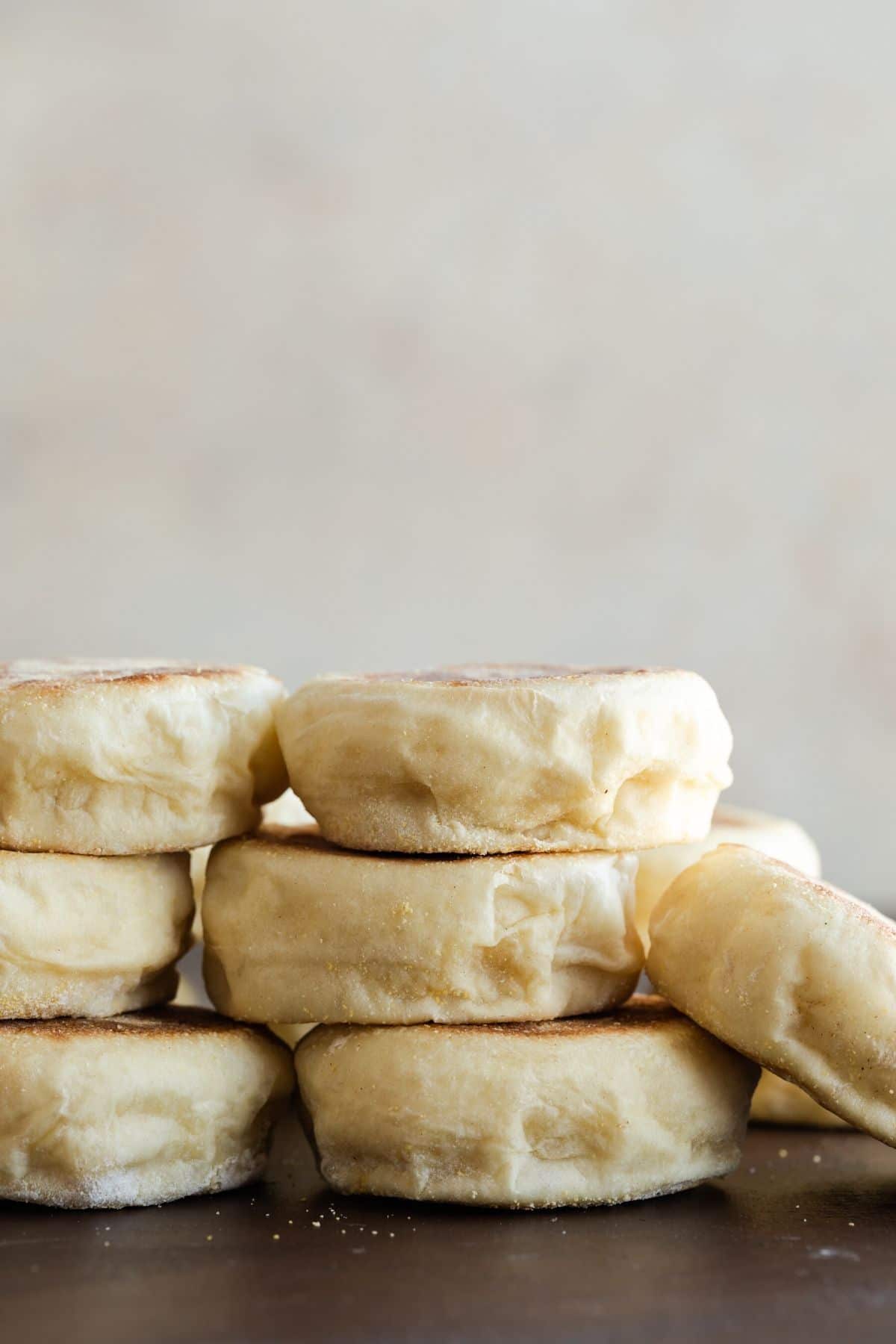
Homemade English Muffins Anyone Can Make
This recipe turned out to be a winner and it’s actually quite simple. Simply mix the ingredients in a stand mixer and let the dough rise, then shape and cook. If you’re looking for a whole wheat version, try my 100% whole wheat English muffins.
Who doesn’t love a toasted English muffin for breakfast?
Unlike banana bran muffins and cinnamon raisin muffins, English muffins are leavened with yeast. They are typically served sliced and toasted with a sweet or savory topping. You can even make sandwiches with them.
With this tutorial, you can make English muffins at home any time you want.
Why this Homemade English Muffins recipe works
- Bread flour is used to give the muffins a chewy texture.
- The dough is sticky! A sticky dough means there’s optimal hydration to yield nooks and crannies that English muffins are known for.
- The muffins are toasted on the stovetop then baked in the oven. Baking them ensure the middle is completely done.
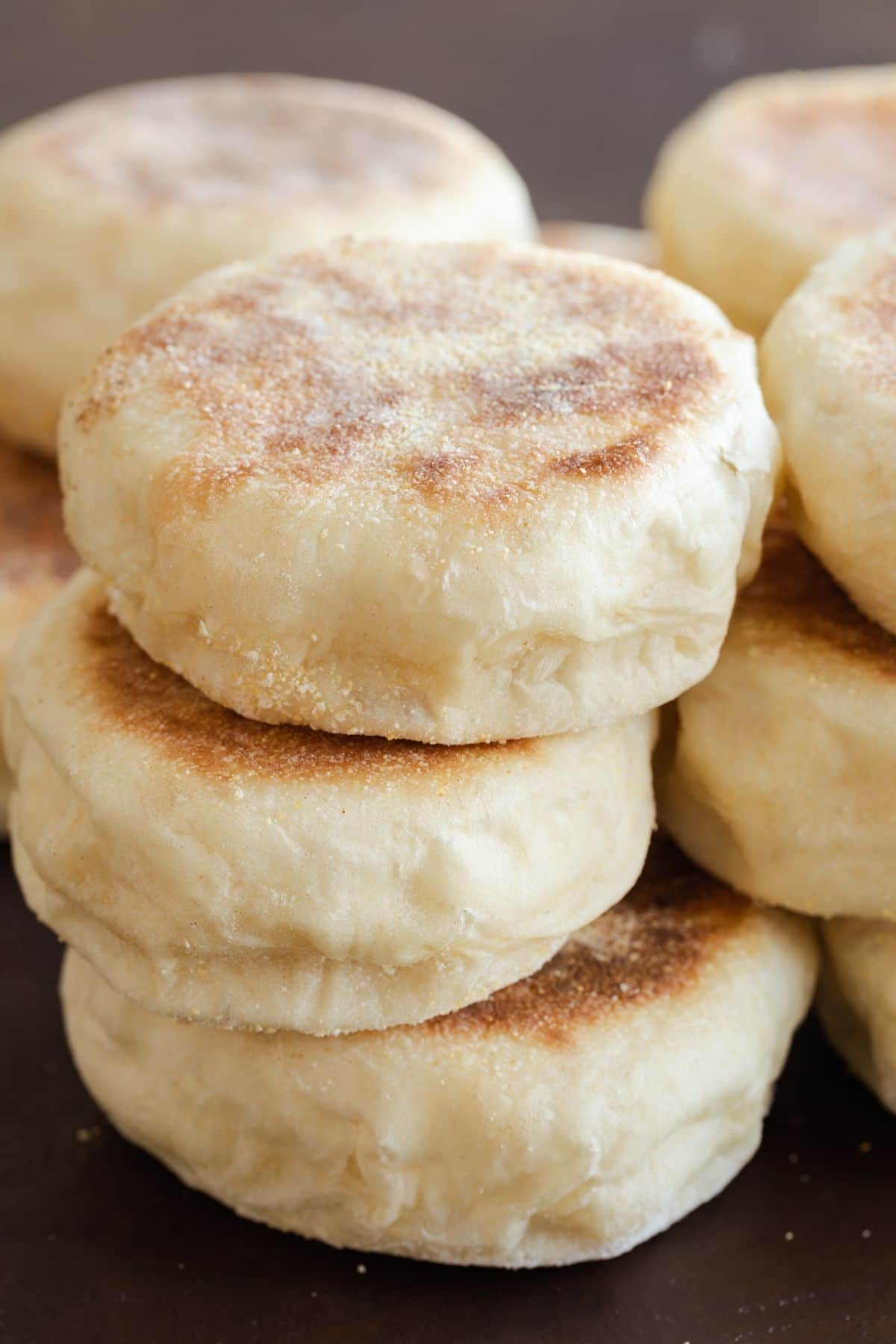
How to make English Muffins
The dough needs two rises. Once right after it’s prepared and once after it’s divided and shaped into English muffins. Let’s go over how to make it. Or you can scroll all the way down to get the full printable recipe with ingredients.
The Dough – This dough recipe is soft and chewy. It’s a basic dough recipe using flour, yeast, milk, sugar, and salt. The dough will be sticky but avoid excess flour. This sticky dough will yield muffins filled with nooks and crannies.
Here’s how to put it together…
Proof the yeast. Warm milk and honey to 105-115°F. Stir in the yeast and set aside for 5 minutes. Then whisk in egg and butter.
Make the dough. Use a stand mixer to make it easier since this dough will be sticky. With the dough hook attached, mix flour and salt together then gradually pour in the yeast mixture. Let the dough mix for about 4 minutes until it turns smooth but is still sticky.
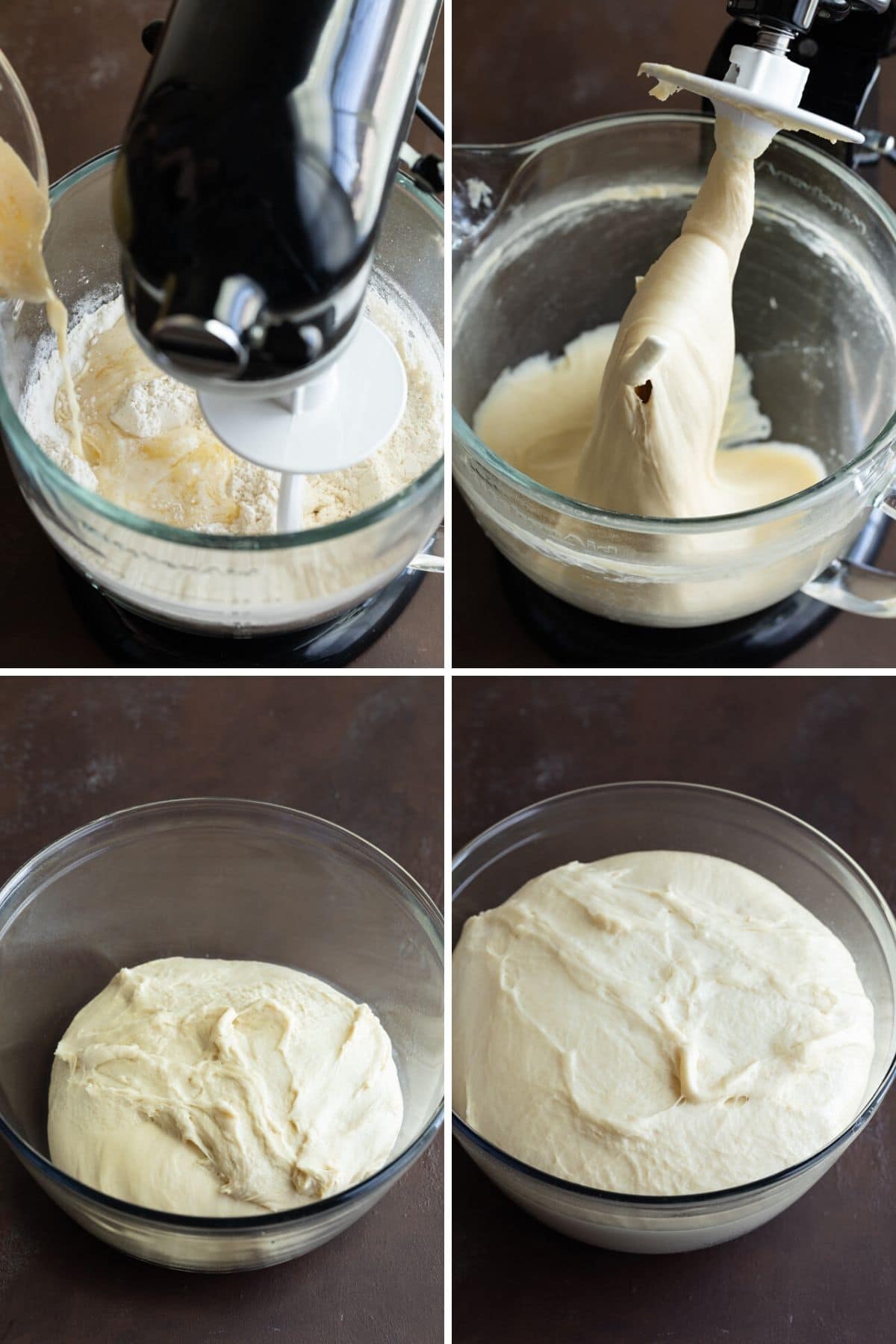
Proof the dough. Scrape the dough into a lightly greased bowl, cover it with plastic wrap and let it rise in a warm place until it’s doubled in size. This can take about 45 minutes to 1 hour.
Divide the dough. Turn the dough out onto a lightly floured surface and divide it into 16 equal-sized pieces. Or you can pinch off pieces of dough and weigh them for more uniform muffins. Each piece of dough should weigh about 78 grams.
You can make smaller muffins by dividing the dough into 22 pieces, each weighing about 57 grams.
Shape the dough. Roll each piece of dough into a ball then flatten the ball into a disk.
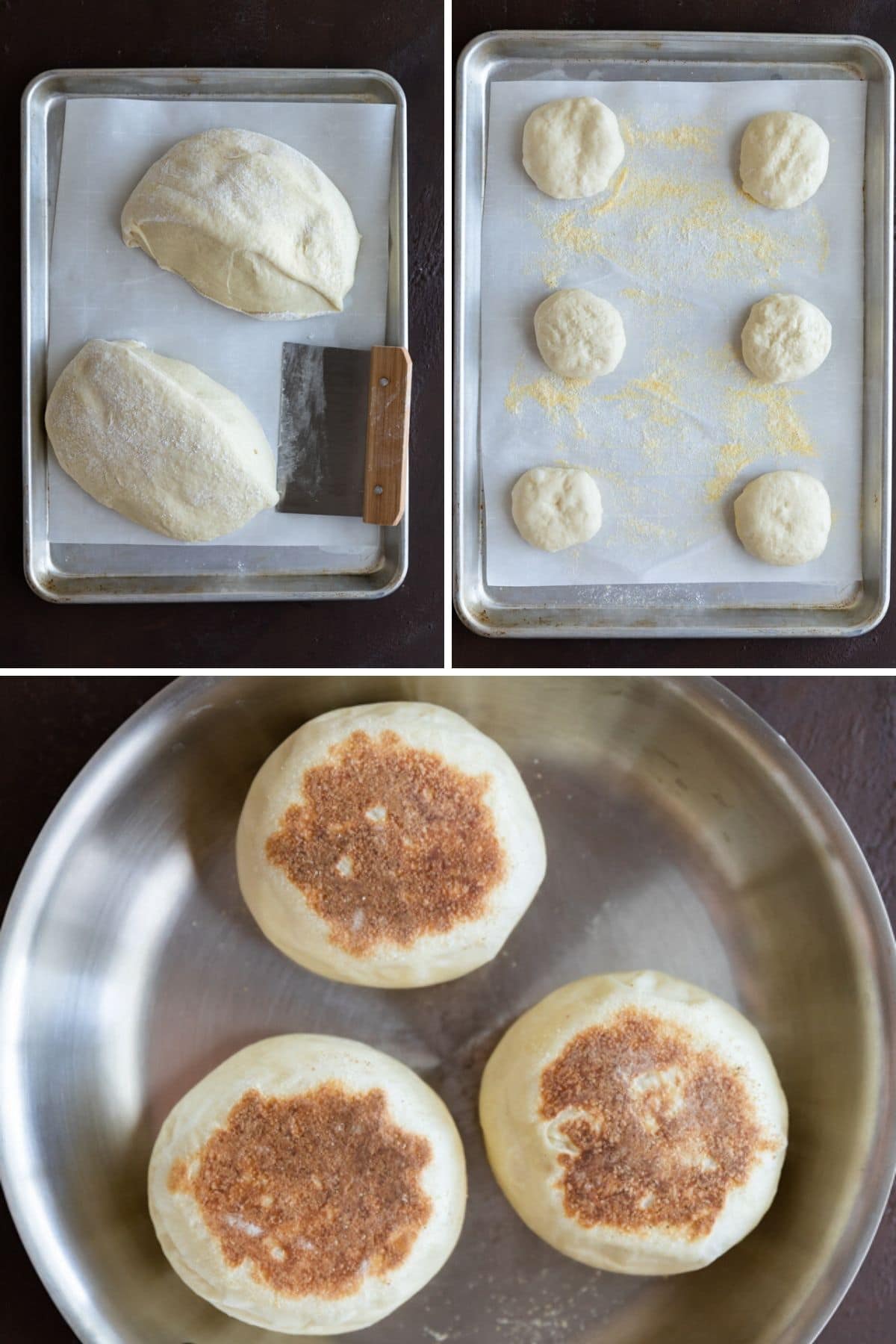
Rise again. Place the disks of dough on baking sheets with parchment paper that has been sprinkled with cornmeal. Sprinkle more cornmeal over the top and cover them with a lint-free towel. Let the dough rise in a draft-free area for 1 hour, until doubled in size.
Cook. On a griddle over medium-low heat, brown both sides of each disk of dough. Return the muffins to the baking sheet and bake for 10 minutes.
Cool. Let the muffins cool completely before slicing or the centers will appear doughy. Once cooled, use a fork to split them open. You can toast them in a toaster or toaster oven and serve them with your choice of toppings.
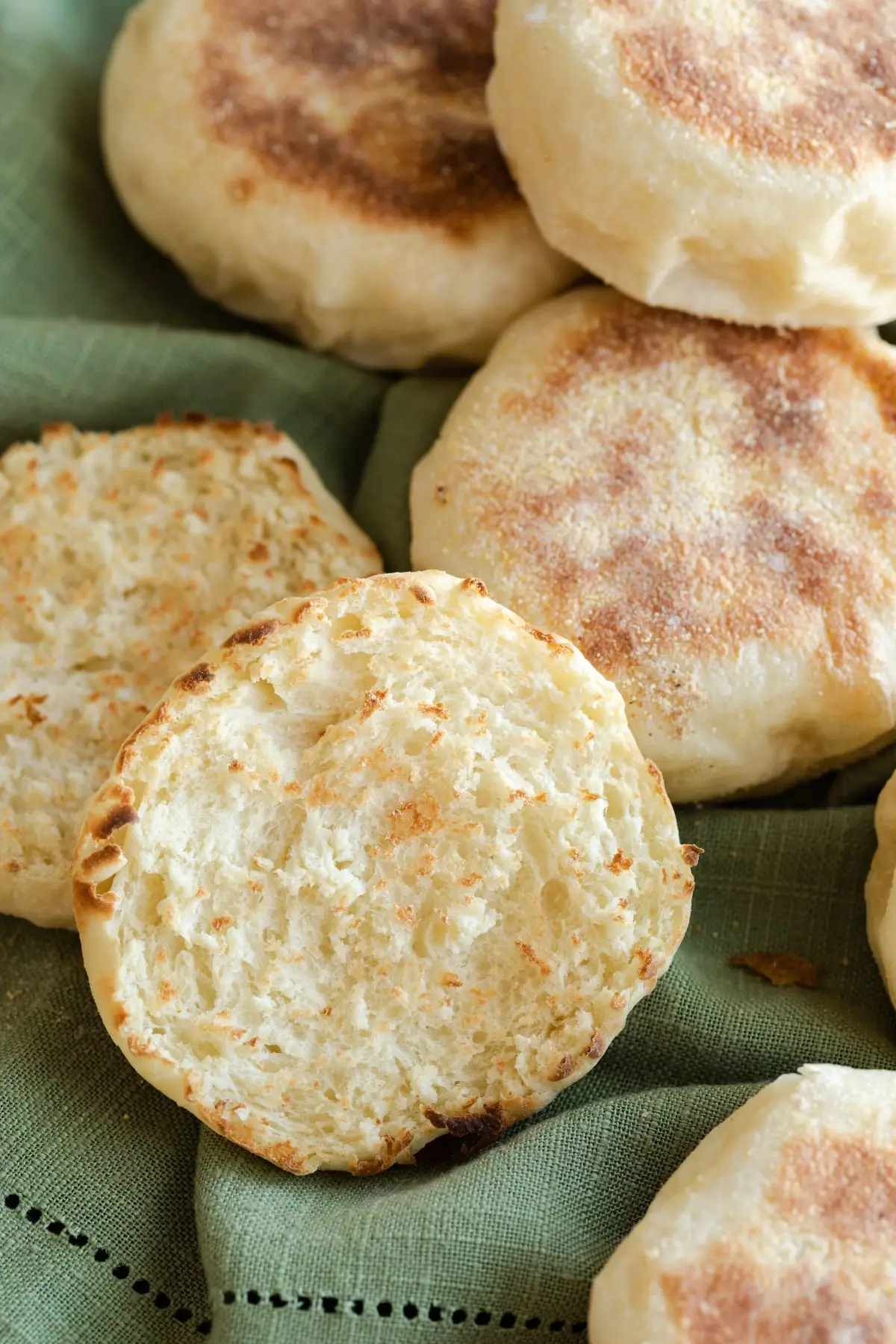
How to store English Muffins?
Keep muffins in an airtight container at room temperature for up to 2 days or in the refrigerator for up to 5 days.
Can you freeze English Muffins?
English muffins freeze well for up to 3 months. Thaw overnight in the refrigerator then warm before serving.
How to toast English Muffins?
Split the muffins open with a fork. This guarantees nooks and crannies! Place each half of the muffin in a toaster and toast until the edges are lightly browned. The end result will be a crunchy and chewy texture. YUM!
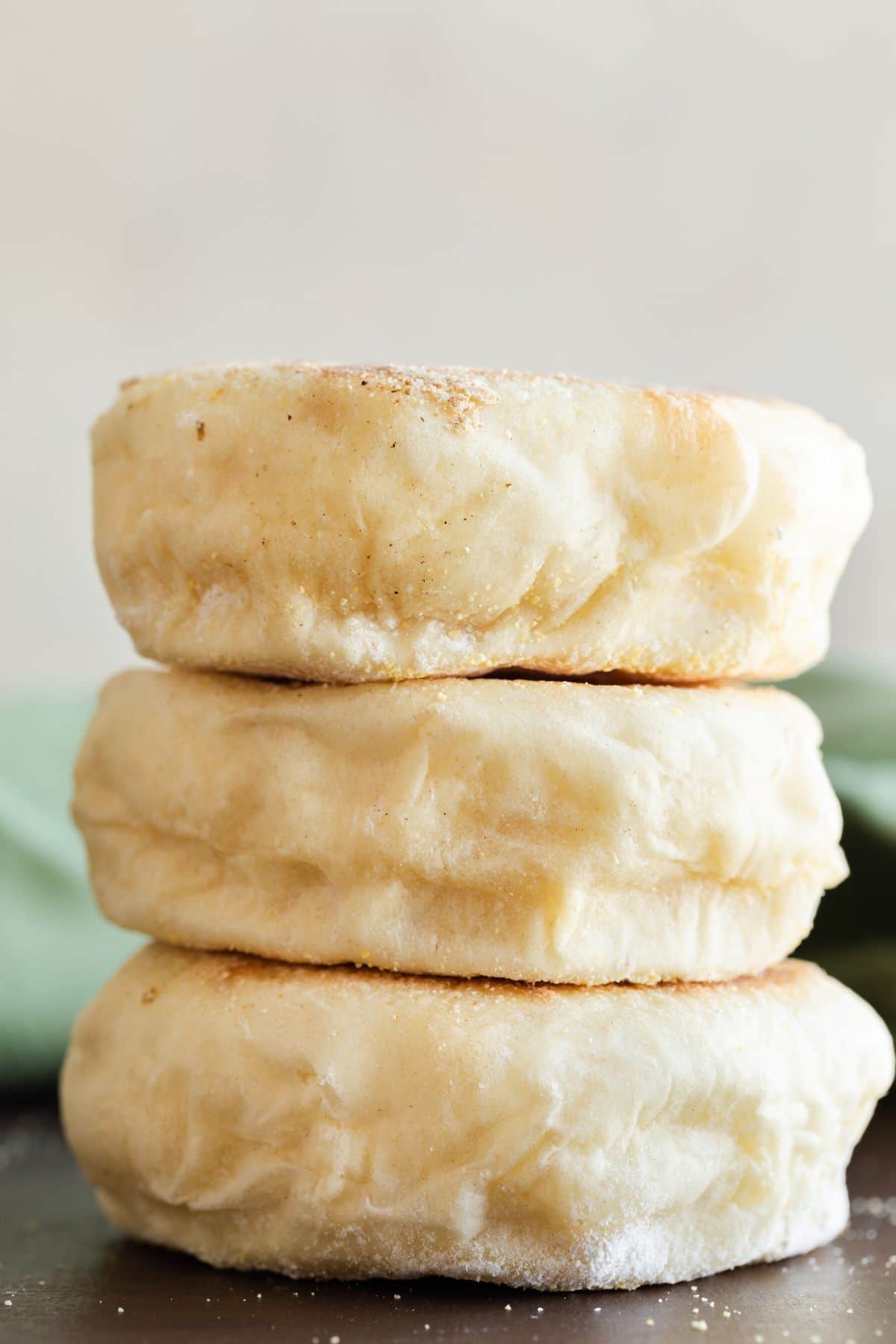
If you like this English Muffin recipe, try these other breakfast recipes:
Homemade English Muffins
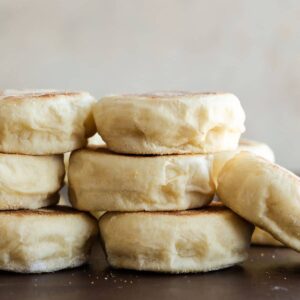
Ingredients
- 2 cups (480 ml) whole milk
- 3 tablespoons honey
- 2 ¼ teaspoons active dry yeast, 1 packet
- 1 large egg
- 4 tablespoons unsalted butter, melted
- 5 cups (650 g) bread flour
- 1 ½ teaspoon salt
- cornmeal, for dusting
Instructions
- In a small saucepan, heat the milk and honey over low heat until it reaches 105-115ºF. Remove from heat, stir in the yeast, and set aside for 5 mins. Whisk in the egg and melted butter.
- Add the flour and salt to the bowl of a stand mixer. Fit the mixer with the dough hook attachment. with the mixer on low speed, gradually pour the milk mixture into the flour.
- Continue to beat on low until the flour is incorporated, stop and scrape down the sides and bottom as needed. Turn the speed up to medium and mix for about 4 minutes, until the dough clears the sides of the bowl and is smooth and elastic. The dough should feel slightly tacky when gently pressed with your fingertip.
- Scrape the dough out into a lightly oiled bowl. Brush a little oil over the top of the dough. Cover and set in a warm place to rise for 1 hour or until doubled in size.
- Gently punch the dough down and turn it out onto a lightly floured surface. Gently knead the dough together into a ball and divide it in half. Divide each half into 8 equal-sized pieces. You should have 16 dough balls. (If you want smaller muffins, divide each half into 11 pieces to equal 22 dough balls.) Roll each piece into a ball and flatten the ball into a disk. (If the dough is too sticky, lightly oil your hands to make it easier to handle the dough.)
- Place the disks on a baking sheet lined with parchment paper that has been dusted with cornmeal. Sprinkle more cornmeal over the tops. Cover with a lint-free towel and set in a draft-free place for 1 hour, or until doubled in size.
- Preheat the oven to 325ºF.
- Heat a griddle over medium-low heat. Gently lift each disk with a plastic spatula and place it on the griddle. (Handle the dough with care so you don’t deflate it) Cook them for about 2 minutes on each side, until lightly browned on both sides. Work in batches.
- Place the muffins back on the cookie sheet and bake them for 10-15 minutes. The internal temperature should be about 200°F on an instant-read thermometer.
- Transfer the muffins to a cooling rack and let them cool completely.
- Split the English muffins with a fork and toast them a toaster until the edges are lightly browned. Serve warm with your favorite jam or butter.
Notes
- Milk: I prefer using whole milk because it yields a rich, tender texture. Some readers have had success using almond milk, oat milk, and skim milk.
- Honey: If you don’t have honey or don’t want to use honey, you may use 1-2 tablespoons of granulated sugar in its place.
- Yeast: This recipe doesn’t call for proofing the yeast in water before you use it. It goes directly into the warm milk to proof. Because of this, it’s important to use brand new yeast that’s well within its expiration date. If you are worried about whether your yeast is good, you can add it to ¼ cup of warm water (105-115°F) with 1 teaspoon of sugar and let it sit for 5 minutes. If it foams, it’s good to use. Omit ¼ cup of milk (so you’d only use 1 and ¾ cups) and add the yeast mixture to the warmed milk mixture as you would in step 1.
- Flour: Bread flour yields the classic chewy texture and will give you the very best results. All-purpose flour may be used by keep in mind it contains less protein and the texture of the muffins may suffer.
- Shaping muffins: To get muffins that are uniform in size, I suggest weighing the dough. For 16 muffins, each portion of dough should weigh 78 grams. For 22 muffins, each portion of dough should weigh 57 grams.
- Muffins are good for up 5 days stored in an airtight container at room temperature or in the refrigerator.
- Muffins can also be wrapped in plastic wrap, sealed in a zip-top bag, and frozen for up to 3 months. Thaw overnight in the refrigerator and toast before serving.
Nutrition
The nutrition information provided is for convenience and as a courtesy only. It is not guaranteed to be accurate because nutrition information can vary for a variety of reasons. For precise nutritional data use your preferred nutrition calculator and input the exact ingredients and brands you used in the recipe.
Adapted from Laura in the Kitchen

We love blueberry english muffins, could you add blueberries? If so what are your suggestions?
I haven’t experimented with adding anything to this dough but I feel like dried fruit may work best. Just add it during step 3, after the flour is just mixed in.
Could I do the first proof in the fridge overnight to make it easier to have these fresh for breakfast in the morning?
That should be fine but it will need 12-18 hours in the refrigerator. And keep in mind that overnight proofing will develop a stronger flavor.
If you do not have a mixer or a scale, what can you do as an alternative? Can I knead it by hand?
I’m not a baker and this will be my first time making it.
Thank you so much!
Make sure to read my post on how to properly measure flour since you don’t have a scale. As far as making the dough without a mixer, you can knead it by hand. Follow the recipe but use a bowl and wooden spoon to mix the dough together then knead it on a lightly floured surface.
Thank you so much! I’ve been wanting to make this recipe, and I feel like now is the time to do it.
What are your thoughts on using all purpose flour in place of bread flour?
Using all-purpose flour in a recipe that calls for bread flour will leave you with a wetter dough. You may need to add additional flour to compensate.
I’m hooked on these homemade English muffins! Delicious.
Thanks so much for providing this.
Can I let the dough rise over night?
I haven’t tried this recipe with an overnight rise but I imagine it would be fine.
I have tried a couple of other recipes the past couple of years and this one, by far, is the easiest and the best one I’ve used. I’m just not sure I know when they’re done. I put them in for 12 minutes and then another 2. I can’t wait to cut one open and try it. thank you for the recipe!
How do you keep from having the English muffins turn hard after you reheat them?
How are you reheating them? It’s recommended to toast them in a toaster. The outside will crispen while the inside remains soft.
I’ve been making these for a long time now. They always turn out differently, sometimes small and thick, other times wide and thinner. But always delicious, and soft. I do make some changes, like half wheat and half bread flour. Oil instead of butter. And reducing honey to 16g. They still taste amazing. My question, when I keep the dough more wet like in your pictures, how do I transfer it to a bowl or divide it into portions, without it getting stuck everywhere, including my hands? Because it’s so sticky, I always find myself adding more flour, which I know will affect the rise, and possibly make them taste more like rolls rather than chewy muffins. Any tips? Special tools I could use?
You can try lightly oiling your hands and work surface to prevent the dough from sticking.
I use my bread maker !! It works perfect ??
Thank you! Unfortunately I do not have a bread machine, but I did use my food processor to knead the dough which made them turn out really good and easier to work with. I also greased my hands with a little leftover oil, in order to handle the dough, and didn’t need any extra flour. They were fluffy and light, and delicious!
I am reading all the comments to try to find out where I went wrong. Mine ended up like hockey pucks. I managed to eat 2 but can’t do it! I don’t know where I went wrong, other than reading about how maybe I didn’t use enough cornmeal, as mine deflated in the transfer to the pan on the stove. Any hints?
It’s really hard to say what went wrong since I wasn’t there to see you make them. But my suggestions would be to make sure you weigh the flour so you aren’t using too much by mistake. And to handle the dough with care so the muffins don’t deflate.
I’ve been making these for so long, and I keep trying different ways to perfect them. The times mine have deflated is because I let them overproof (leaving them to rise for too long). Also, when I handle the dough too much or add too much extra flour, they become denser and harder. Maybe these could be some of the reasons?
Can I make this using instant yeast and how would I go about it?
Follow the same process. The only difference is the rise time will most likely need to be shortened. Only let the dough rise until doubled in size.
I followed the recipe with quick yeast, using my bread maker on the dough setting. It worked great all the way to the end. So yummy!!